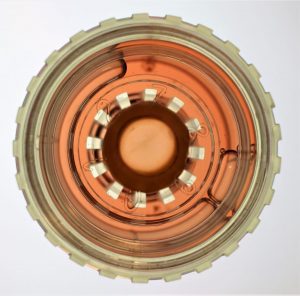Give the Gift of Sight
You can help give the gift of sight to those who need it most.
Annually, Lions Eye Bank of Wisconsin (LEBW) places over 1,800 corneas worldwide, serving Wisconsin’s corneal surgery needs first.
Why should you be a donor?
- Age, gender, race and quality of sight are not causes in cornea donation.
- Eye donation is supported by all major religions. Some view donation as an act of charity and/or a personal choice.
- Donation is a gift – there is no cost to you or your family to donate.
- Click here for eye donation facts.
Referral
Lions Eye Bank of Wisconsin (LEBW) partners with the designated Organ Procurement Organization and the Tissue Bank to facilitate donation throughout Wisconsin. Our donor coordinators work closely with all facilities to obtain patient medical information and to determine donor registry status.
Authorization/Medical Record Review
Once the Lions Eye Bank of Wisconsin is notified of a potential donor, donor coordinators obtain basic medical info such as: age, time & cause of death, medical history, and next-of-kin information. LEBW then contacts the next of kin, to obtain consent for the donation of the individual’s corneas or whole eye.
Recovery
Eye tissue must be recovered and preserved within a few hours of the patient death. LEBW has technicians on call 24/7. When the technician arrives, he/she reviews the medical chart and performs a physical inspection. The technician then creates a sterile environment and removes the viable tissue.
Transportation
The Lions Eye Bank of Wisconsin uses a unique process to help transport corneal tissue throughout the state it is known as the “Cornea Express”. When a donation has occurred and tissue is recovered, local Lions clubs are called upon to transport the corneal tissue back to the Eye Bank via a relay system.
Evaluation
Eye tissue is evaluated through the use of a slit lamp and under the use of a specular microscope. If the tissue is free of imperfections and a has medical record clearance, the tissue can be used for transplant, research, or education and training.
Tissue Release
The Medical Director Designee authorizes the release of the tissue. The eye tissue is then offered out for transplantation, research, or education and training. After being sealed and packaged the eye tissue leaves our facility to it’s new home.
Frequently Asked Questions
Donor Eligibility
Everyone is encouraged to become a donor with the knowledge that eligibility is determined near or at the time of death, and on a case by case basis after a thorough medical review. Patients with cancers, malignancies, diabetes, and macular degeneration may often be eligible as donors for transplant use, as well as many patients who wear glasses or contact lenses.
About the Eye
 THE CORNEA
THE CORNEA
The cornea is the clear front window of the eye. It transmits light to the interior of the eye allowing us to see clearly. Injury, disease, or hereditary conditions can cause clouding, distortion, and scarring of the cornea. Corneal clouding, much like frost on a glass windowpane, blocks the clear passage of light to the back of the eye, reducing sight, sometimes even to the point of blindness. In addition, corneal injury and disease can be incredibly painful.
CAUSES OF CORNEAL INJURY
Knives, pencils, and other sharp objects can cause severe injury to the cornea. Fireworks, exploding batteries, and toxic chemicals, especially alkalis, can also result in severe scarring of the cornea. In fact, protection of the cornea is the reason emergency washing of the eye is necessary when exposed to toxic chemicals. Most corneal injuries are preventable with protective glasses and proper precautions when dealing with hazardous substances.
CAUSES OF CORNEAL DISEASE AND DEGENERATION
Infections, whether bacterial, fungal, or viral, are frequent causes of severe corneal damage and ulceration. Abnormal steepening of the cornea (keratoconus), degeneration occasionally following cataract surgery (corneal edema and swelling), and some aging processes can also affect the health of the cornea.
CORNEAL TRANSPLANTS
If the cornea becomes cloudy, the only way to restore sight is to transplant the cornea. Corneal transplantation (keratoplasty) is the most successful of all tissue transplants with an overall success rate of over 90%.
Corneal tissue for transplants comes from an eye bank, such as Lions Eye Bank of Wisconsin. The process begins at the passing of someone who has been generous enough to become a donor. Surgeons register their transplant surgery dates with LEBW. At the appropriate time, staff contacts the surgeon. The operation consists of a transfer of the clear central part of the cornea from the donor’s eye to the patient’s eye. Soon after the operation, the patient can resume a normal life.
AFTER SURGERY
Return of best vision after corneal surgery may take up to a year after the operation, depending on the rate of healing and the health of the rest of the eye. Aswith transplant, rejection of the donated tissue is possible. The major signs of rejection are: redness of the eye or worsening of vision. If these occur, prompt return to the ophthalmologist is necessary, even if it is years after the original procedure.
REGULAR MEDICAL EYE EXAMINATIONS ARE IMPORTANT
Eye disease can strike at any age. Many eye diseases do not cause symptoms until the damage has already occured. Most blindness is preventable if diagnosed and treated early; therefore, regular medical examinations by an ophthalmologist are important! Why an ophthalmologist? Because only an ophthalmologist (MD) can provide total care for your eyes: medical, surgical, and optical.
